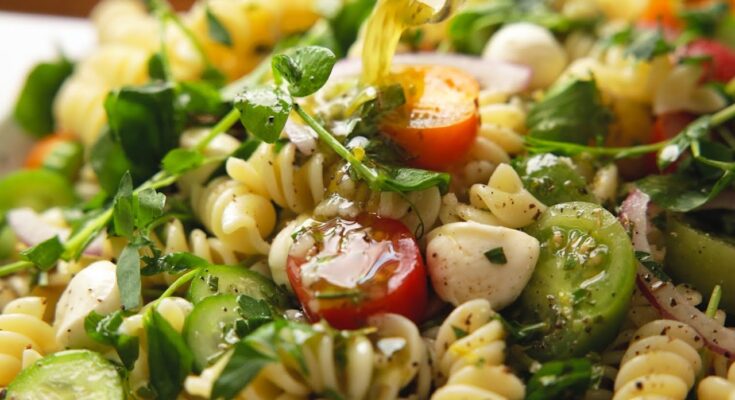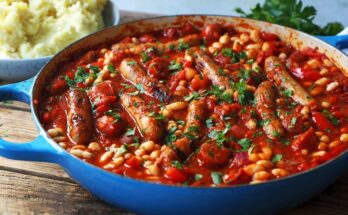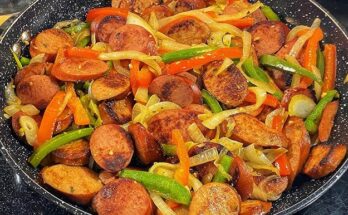Pasta Salad Recipe: Pasta salad is one of those versatile dishes that you can whip up for any occasion. Whether it’s for a summer barbecue, a potluck, or just a quick weeknight dinner, pasta salad is the perfect solution. It’s hearty, refreshing, and endlessly customizable. The combination of tender pasta, crunchy veggies, and zesty dressing makes it a crowd favorite. Plus, it’s super easy to make!
In this guide, I’ll walk you through everything you need to know to make the best pasta salad from scratch. Whether you prefer a classic Italian pasta salad or something more creative, this recipe will give you all the tips and tricks you need.
Key Ingredients for the Perfect Pasta Salad
Before we dive into the step-by-step process, let’s take a look at the key ingredients you’ll need to make a stellar pasta salad.
Choosing the Right Pasta
The type of pasta you choose plays a big role in the final dish. Short pasta like rotini, penne, or fusilli is ideal because the shapes hold onto the dressing and other ingredients. Avoid long pasta like spaghetti or fettuccine, as they don’t work as well in cold salads.
Fresh Vegetables to Use
Fresh, crisp vegetables are a must! Cucumbers, bell peppers, cherry tomatoes, red onions, and olives are all great options. The vegetables add a burst of flavor and texture that balances the soft pasta.
Best Dressings for Pasta Salad
Dressings can make or break your pasta salad. Classic vinaigrettes with olive oil, vinegar, and herbs work beautifully, but you can also go for creamy dressings like ranch or mayonnaise-based options for a richer taste.
Optional Add-ins for Extra Flavor
Want to jazz up your pasta salad? Try adding cheese (feta or mozzarella), olives, nuts (like pine nuts or walnuts), and even fruits like grapes or apples for a sweet twist. The possibilities are endless.
Types of Pasta for Salad
Not all pasta is created equal when it comes to making pasta salad.
Short Pasta Varieties
Rotini, penne, farfalle, and fusilli are some of the best options. Their ridges and curves trap dressing and small bits of veggies, making each bite flavorful.
Gluten-Free Pasta Options
For those with dietary restrictions, there are plenty of gluten-free pasta options made from rice, corn, or quinoa. They’re just as delicious but be sure to follow the cooking instructions carefully to avoid overcooking.
Whole Wheat or Classic Pasta: What Works Best?
Whole wheat pasta adds a nutty flavor and more fiber, making your pasta salad a bit healthier. However, classic semolina pasta gives you that traditional taste and texture most people are used to.
Vegetables and Proteins for Your Pasta Salad
Now that your pasta choice is sorted, it’s time to consider your vegetables and proteins.
Fresh and Crunchy Veggies
Crispy vegetables like cucumbers, bell peppers, carrots, and red onions give your salad a vibrant crunch. Blanching tougher veggies like broccoli or asparagus will soften them slightly while keeping their bite.
Best Proteins to Add
If you want to make your pasta salad more filling, add some protein! Grilled chicken, tuna, shrimp, or chickpeas are excellent choices. Vegetarian options like tofu or tempeh also work well for a protein-packed dish.
Dressings and Sauces
The dressing ties everything together, so it’s important to choose the right one.
Classic Vinaigrette
A vinaigrette made with olive oil, red wine vinegar, Dijon mustard, and Italian herbs is a classic choice for pasta salad. It’s light, tangy, and perfect for warm weather.
Creamy Dressings
If you prefer a richer flavor, creamy dressings made from mayonnaise, sour cream, or Greek yogurt are a delicious option. They coat the pasta and veggies in a luscious, creamy texture.
Lemon and Herb-Based Dressing
For a fresh and light twist, try a lemon and herb dressing. The citrusy notes from the lemon combined with fresh herbs like basil, parsley, and thyme give the salad a refreshing taste.
Step-by-Step Guide to Making the Perfect Pasta Salad
Here’s how to create a delicious pasta salad in just a few simple steps.
Boiling the Pasta Perfectly
Cook the pasta in salted boiling water according to the package instructions, but take care not to overcook it. Aim for al dente so the pasta holds up well in the salad. Once it’s done, drain and rinse it under cold water to stop the cooking process.
Prepping the Vegetables
While the pasta is boiling, chop your vegetables into bite-sized pieces. Keep them roughly uniform in size so they mix well with the pasta.
Mixing the Dressing
In a small bowl, whisk together your dressing ingredients. For a vinaigrette, mix olive oil, vinegar, mustard, and seasonings. For a creamy dressing, blend mayonnaise or yogurt with lemon juice, garlic, and herbs.
Assembling Your Pasta Salad
Combining the Ingredients
In a large bowl, combine the cooked pasta, chopped vegetables, and any proteins or extras you’re using. Pour the dressing over the top and toss everything together until it’s well coated.
Adjusting the Flavors
Taste your salad and adjust the seasonings as needed. You may want to add more salt, pepper, or a splash of vinegar to balance the flavors.
Tips for a Flavorful Pasta Salad
Letting the Salad Sit for Better Flavor
Pasta salad tastes even better if you let it sit for a while. Allow the flavors to meld for at least 30 minutes before serving.
Seasoning Tips for Extra Zing
A pinch of red pepper flakes, a dash of lemon zest, or a drizzle of balsamic glaze can elevate your pasta salad to the next level.
How to Keep the Salad Fresh and Crisp
If you’re making the salad ahead of time, keep the dressing separate and toss it in just before serving. This helps prevent the veggies from getting soggy.
Serving Suggestions
Pairing with Main Courses
Pasta salad pairs beautifully with grilled meats, seafood, or as a side to sandwiches. It’s also great as a light lunch on its own!
How to Serve Pasta Salad at Parties
For parties, serve your pasta salad in a large, colorful bowl and garnish it with fresh herbs or grated cheese for a visually appealing presentation.
Storing Leftovers
How to Store Pasta Salad for Later
Store your pasta salad in an airtight container in the fridge. It will keep for up to 3-5 days, making it a great make-ahead meal.
Best Containers for Keeping Pasta Salad Fresh
Glass or plastic containers with tight-fitting lids work best to keep your salad fresh and prevent any odors from seeping in.
Variations of Pasta Salad
Mediterranean Style Pasta Salad
Add feta cheese, Kalamata olives, sun-dried tomatoes, and a drizzle of olive oil for a Mediterranean-inspired dish.
Classic Italian Pasta Salad
Mix in salami, mozzarella balls, roasted red peppers, and artichoke hearts for a hearty Italian-style salad.
Creamy American Pasta Salad
For a more traditional American version, use elbow macaroni and a creamy dressing made from mayo, sour cream, and mustard.
Healthy Pasta Salad Tips
How to Make a Low-Calorie Version
Use whole wheat pasta and a lighter vinaigrette to cut down on calories without sacrificing flavor.
Using Whole Grains and Lean Proteins
Substitute regular pasta with whole grain or legume-based pasta and add lean proteins like grilled chicken or chickpeas for a healthier option.
Common Mistakes to Avoid
Overcooking the Pasta
Overcooked pasta will become mushy when mixed with dressing, so be sure to cook it to al dente.
Skipping the Cooling Step
Always rinse your pasta under cold water to stop the cooking process and cool it down before mixing with other ingredients.
Overloading with Dressing
Too much dressing can make your salad heavy and soggy. Start with a little and add more as needed.
Customizing Your Pasta Salad
Vegetarian and Vegan Options
Leave out the meat and cheese, and use a vegan-friendly dressing to make a delicious vegetarian or vegan pasta salad.
Adding Fruits and Nuts
For a sweet and savory mix, try adding fruits like grapes, apples, or dried cranberries, and nuts like almonds or walnuts.
FAQs about Pasta Salad Recipe
1. What type of pasta is best for pasta salad?
For pasta salad, short pasta like rotini, penne, or farfalle is ideal. These shapes hold sauces and add texture, making your salad more flavorful.
2. Can I make pasta salad ahead of time?
Yes! Pasta salad can be made a day ahead. In fact, preparing it in advance allows the flavors to blend better, making it even more delicious.
3. How long can pasta salad last in the fridge?
Pasta salad can be stored in an airtight container in the fridge for up to 3-5 days. Be sure to stir before serving to refresh the ingredients.
4. What are some good ingredients to add to pasta salad?
Common additions include vegetables like cherry tomatoes, cucumbers, bell peppers, olives, and proteins like chicken or tuna. You can also add cheese, such as feta or mozzarella.
5. Can I use gluten-free pasta for pasta salad?
Absolutely! Gluten-free pasta works well in pasta salad. Just ensure you follow the cooking instructions, as gluten-free pasta may have a different texture than regular pasta
Conclusion
Crafting the perfect pasta salad is all about creativity and balance. Whether you’re looking for a quick lunch or a side dish for a gathering, this versatile meal allows endless customization with your favorite ingredients.
From choosing the right pasta shape to experimenting with a variety of dressings, you can make a dish that’s both delicious and satisfying. Remember, the key to the best pasta salad is fresh, quality ingredients and a willingness to try new flavor combinations.
So, have fun in the kitchen and enjoy the endless possibilities!
References
For more information and to explore other exciting variations of pasta salad, here are some reputable sources you can check out:
- AllRecipes – Explore a wide variety of pasta salad recipes tailored to different tastes. Visit AllRecipes
- BBC Good Food – Learn tips and tricks from expert chefs on perfecting your pasta salad. Visit BBC Good Food
- Delish – Discover creative and easy-to-make pasta salad ideas for every occasion. Visit Delish
These resources provide additional insights into ingredients, preparation methods, and ways to elevate your pasta salad dish.



